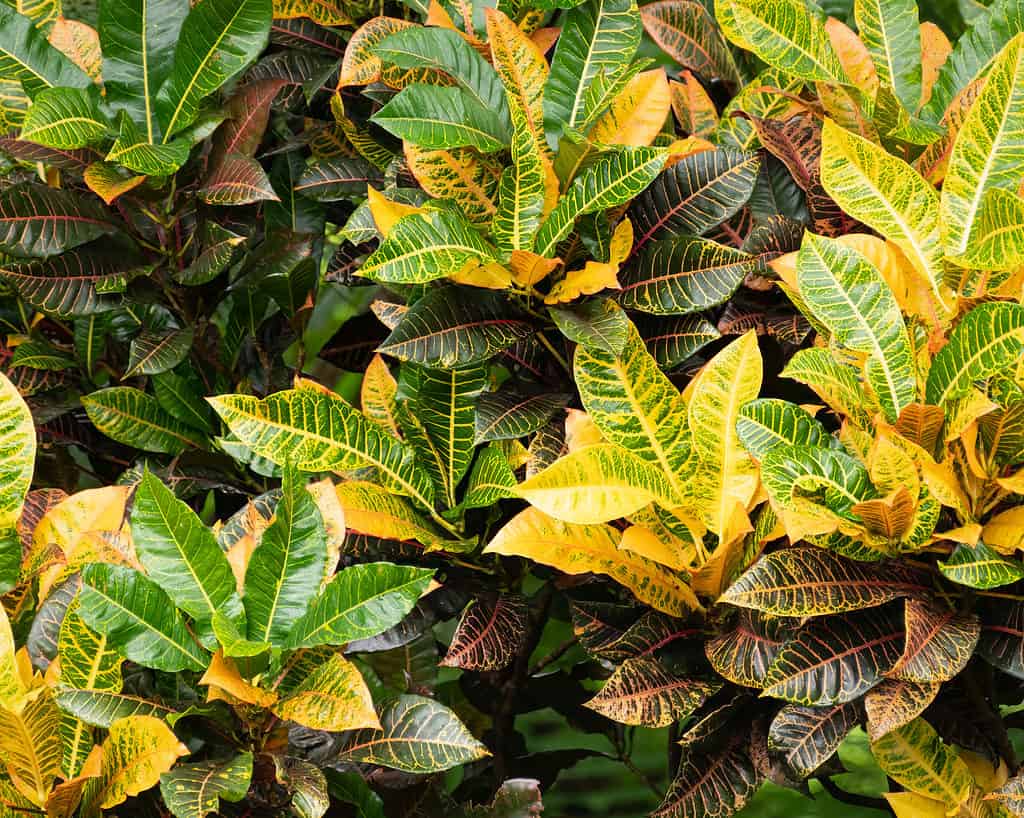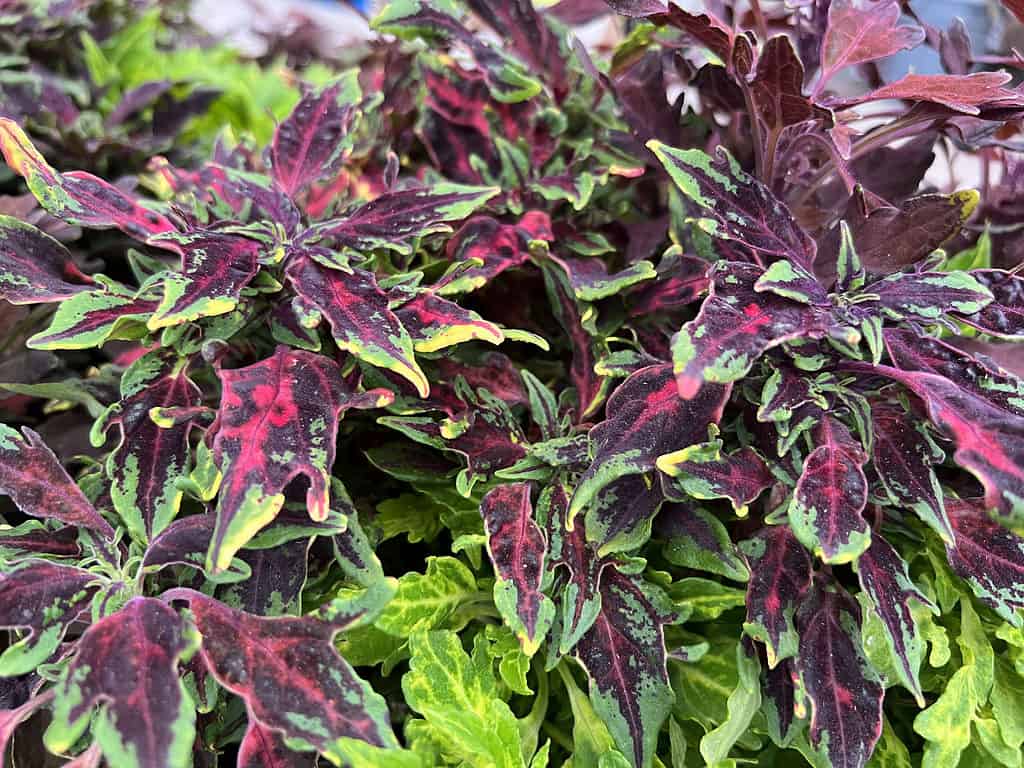There’s no plant quite like the croton plant! This beautiful tropical species is known for growing quite large and boasting extremely bright and colorful foliage. While this species can definitely produce flowers, their flowers are far from the focal point of the plant. Rather, its colorful leaves are what really draws the eye. There are dozens of croton varieties out there, all of which boast a mix of green, yellow, orange, red, and even purple variegated patterns.
Do you want to grow your own croton plant? If so, we’ll break down everything you need to know about this one-of-a-kind plant that can be grown anywhere, provided it has the right humidity, temperature, sunlight, and space requirements to help it thrive. These plants can occasionally be a bit picky, but most tropical plants tend to be that way. With just a little bit of attention, your own croton will grow beautifully!

Crotons (pictured) can come in many different colors, all within the same plant!
©iStock.com/Malcolm
What is a Croton Plant?
Crotons, sometimes referred to by their species name Codiaeum variegatum, are gorgeous houseplants that are grown for their vivid and eye-catching leaves. Six species of broadleaf evergreen perennials, shrubs, and small trees that are native to nations in tropical and subtropical Asia as well as the Pacific Islands make up the Codiaeum genus. This genus is a member of the Euphorbiaceae family.
The croton is an evergreen shrub or small tree that has been developed into several varieties (which we’ll cover later in this guide), each with unique variations in leaf color and design. Although many people have had success growing this plant in USDA hardiness zones nine and 10, it is a perennial that is only truly hardy in zones 11 and 12.
In its native environment, this branching, bushy shrub may grow as high as eight or 10 feet. The linear to oval leaves are glossy, variegated, and have a smooth or lobed border. The margins of some of the leaves are likewise wavy or swirling. In various combinations, the leaf’s hue can range from green to white, pink, red, or yellow. You might even find a variation of this plant that has purple in its leaves! To learn more about Codiaeum variegatum, check out our article here.
Planting Croton Plants Indoors
Croton plants thrive well outside in warm, humid climates. They favor plenty of water and bright light over diffused light. It could be difficult for certain people in some places to cultivate these plants inside because it is necessary to replicate their ideal native conditions.
However, this plant may be relatively simple to cultivate inside if you mimic its natural outdoor setting via temperature and humidity. The croton grows considerably more compactly in pots than it does outdoors, where it may reach heights of up to eight feet, making it an excellent indoor plant. The height of Codiaeum variegatum frequently increases by about a foot per growing season. However, regular repotting and the right amount of care could easily result in an eight-foot-tall indoor plant. Even though it grows more slowly than other plants, considering its enormous mature size, the wait will be worthwhile! To learn more about growing a croton plant indoors, check out our in-depth guide here.

Potted crotons (pictured) can thrive indoors as long as their tenperature, humidity, water, and sunlight needs are met.
©Anastasia Gubinskaya/Shutterstock.com
Planting Croton Plants Outdoors
As mentioned earlier, croton plants grow well outdoors. However, they have pretty strict needs in terms of their environment. USDA hardiness zones nine through 11 are suitable for these plants to survive the winter. Some varieties even do well in zone 12. However, you’ll be hard-pressed to find a croton species or variety that could handle the climate of USDA hardiness zones eight and below. They are tropical plants that need lots of heat, usually between 60 degrees F and 80 degrees F. They also night plenty of bright direct and indirect sunlight, so cloudy climates simply won’t do. These plants are extremely sensitive to cold and will not tolerate a frost.
Some plant enthusiasts in colder climates will keep their crotons in pots during the summer and will bring them indoors during the winter, which could work if you’re mindful of the temperature each day. To discover more about growing croton plants outside, check out our article here.
Watering Croton Plants
Croton plants lose a substantial quantity of moisture through a process called “transpiration” from their enormous, bright leaves. They should be watered often but not excessively, as they prefer wet, humid environments. A good way to provide adequate water and humidity for your plant is by misting and watering the soil on a regular basis, but only when the leaves and soil appear dry.
Check the moisture level beneath the surface of the soil whenever it seems to be dry by poking it with your fingers. The top half inch of soil should feel dry before we recommend watering. Water the plant from the base as opposed to the top to prevent the water off the foliage. Too much moisture on the foliage might lead to fungal problems. To discover more about watering requirements for croton plants, check out our in-depth article here.
Light Requirements for Croton Plants
Sunlight is the most challenging thing to provide for indoor croton plants. These plants are often a little less picky about the quantity of light they receive, despite the fact that it might be challenging to replicate the precise amount of sunshine that they would receive in their native habitat. Even so, giving your croton houseplants the correct amount of light will result in brighter colors and more developed leaves. Since these plants are distinguished by their colorful, eye-catching leaves, this is quite important.
In general, these plants require bright light. Croton plants demand bright light with a minimum of 1000 foot candles. The variety or cultivar of the plant you select will determine whether it prefers direct or indirect light. These plants benefit from daily sun exposure of at least six hours. To learn more about the light requirements for the croton plant, check out our guide here.

The better the sun exposure, the more colorful the croton’s foliage (pictured) will be.
©iStock.com/Sean K Brewer
Common Croton Plant Problems, Diseases, and Pests
No houseplant is without its issues, and the croton plant is no different. For these plants specifically, the most common ailment they will suffer from is brown leaves or burnt leaf tips. Inappropriate watering techniques and a lack of humidity are the two most common reasons for croton leaves that are turning brown and feeling crispy. However, if you discover little brown spots that are surrounded by yellow on their leaves, your plant could be suffering from a leaf spot disease.
If the condition is caused by a fungal infection, remove the damaged leaves, keep their leaves dry when watering them, and increase airflow around the plant. These adjustments often serve as a treatment for the fungal illness. Other common issues that these plants experience include yellowing leaves, loss of color, dropped leaves, wilting leaves, mites, mildew, scale, and aphids. To learn more about common issues plant parents face when it comes to croton plants, check out our guide to problems and solutions here.
How to Propagate Croton Plants
If you have one croton plant, chances are that you have fallen in love and want even more of them. Luckily, propagating croton plants is very easy to do. Croton plants can be propagated via cuttings. These cuttings can be placed in water or in soil throughout the propagation process. Once the cuttings have grown roots, they can then be transplanted into new pots and grown as new croton plants. To discover more about the propagation processes for croton plants, check out our article here.
Beautiful Croton Plant Varieties
One of the coolest things about crotons is that there are many different varieties available. The main species of crotons that are used as houseplants is Codiaeum variegatum. This species has dozens of different varieties and cultivars.
One popular variety of crotons is the Gold Dust croton, also known as Codiaeum variegatum ‘Gold Dust’. The Gold Dust croton plant has glossy golden gold flecks throughout its dark green foliage. This evergreen shrub may reach a height of three to six feet, needs very little maintenance, and is easy to keep healthy with a little bit of daily TLC. It grows rather slowly, so you shouldn’t be worried about it taking over your garden or growing out of its indoor pot.
Another excellent variety is the Mammy croton. It has enormous, heavy, glossy, leathery leaves that twist, coil, and corkscrew as they reach maturity. On the leaves of this variety, you might just notice vibrant shades of yellow, pink, red, orange, and other colors. The Mammy croton fits perfectly in any space with enough lighting. Because it prefers high humidity, you may also put it in a bathroom with a window or skylight.
A few other popular varieties of Codiaeum variegatum include the Sunny Star croton, the Freckles croton, the Zanzibar croton, the Victoria Bell croton, and the Mother and Daughter croton. The two latter varieties are particularly popular for their bell-shaped leaves and baby plants that give each a very unique look when compared to other croton varieties. To learn more about the many beautiful varieties of croton plants, check out our article here.
We can’t talk about popular croton varieties without talking about the stunning Petra! Croton Petra is a wonderful ornamental plant with stunningly colored variegated leaves. The leaves are oval in shape, shiny, and usually have aesthetically pleasing pointed tips. Pink, red, orange, yellow, and light and dark green are among the spectrum’s hues. Some Petras will even boast a bit of violet in their leaves! The leaf veins are a lighter green and provide a fascinating variegated appearance. This variety, like many crotons, is known for being highly dramatic when they are not kept in perfect condition. Poor upkeep will result in them significantly drooping or losing their leaves. But, if you give them the right temperature and humidity, they should do just fine indoors. To learn more about the Petra variety of croton plants specifically, check out our guide to this cultivar here.
There’s simply so much to love about the croton plant! If you have a pet-free space, can handle the humidity and temperature requirements, and have some experience when it comes to houseplants, this is the perfect plant for you.
Up Next:
- Philodendron Golden Goddess vs. Thai Sunrise
- Are Monstera Plants Toxic to Cats or Dogs?
- Is Lantana a Perennial or Annual?
The photo featured at the top of this post is © iStock.com/Hanna Yohanna
Thank you for reading! Have some feedback for us? Contact the AZ Animals editorial team.







